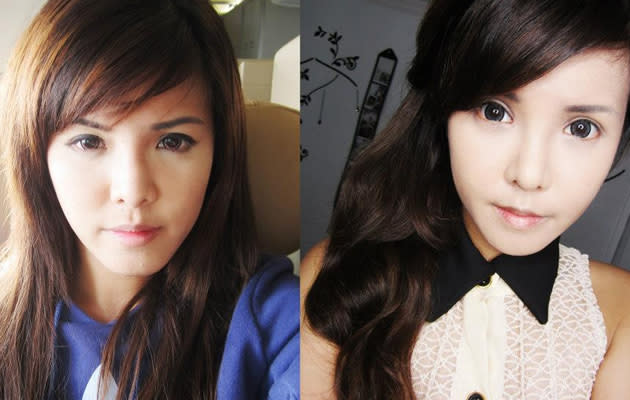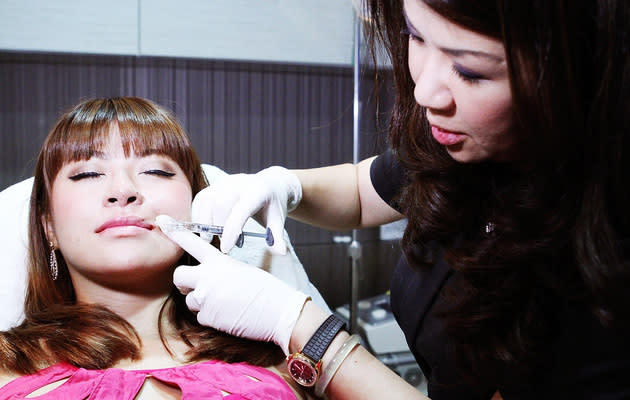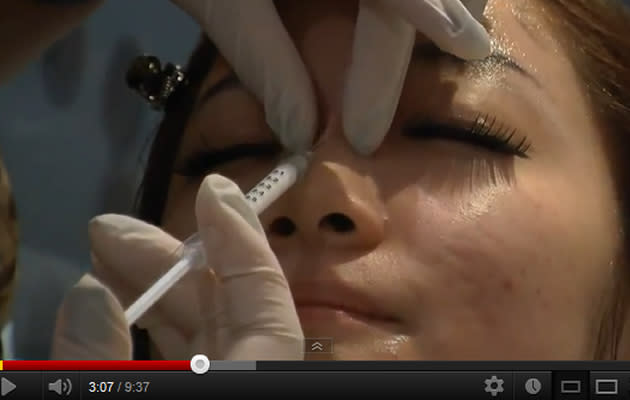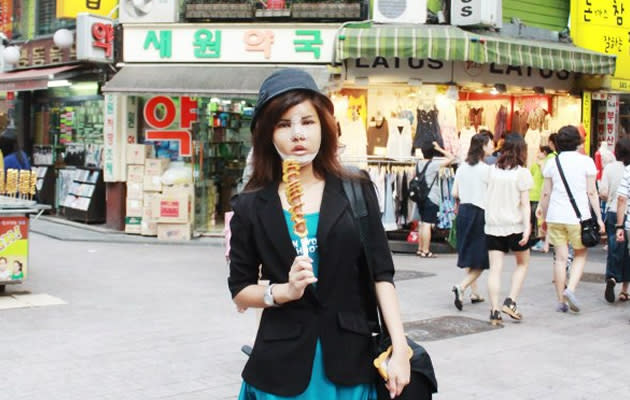Singapore’s ‘Go Plastic’ phenomenon (Part 1): Youths fixated with fillers

Plastic surgery in 2012 is hot, especially among the young. Fast becoming a topic discussed as flippantly as what to have for lunch, non-invasive procedures like fillers can be done in less time than it takes to finish your meal. 8 out of 10 women in Singapore aged between 20 and 25 will soon have had some form of aesthetic work done to their faces or bodies, doctors told Yahoo! Singapore. In part 1 of this two-part series, Elizabeth Soh and Gail Chai find out what's driving the 'Go Plastic' phenomenon.
Going for cosmetic surgery used to be a taboo, hush-hush affair.
Women who went for a quick "nip and tuck" would disappear to heal in quiet, emerging later with a fresh-faced new look. Admitting that you had "work done" was just not done -- not least for fear of being judged by colleagues, friends or family.
Not so anymore. Increasingly, women in their 20s and as young as 18 are popping into aesthetic clinics during lunch for a quick "filler fix" and emerging with higher, rounder cheekbones in 30 minutes. Some who are braver go for more radical transformations involving cuts and facial restructuring.
Proud of their new look, they unashamedly upload "before and after" photos online with remarks like "loving my new high nose bridge! You guys need to try it out". Young female beauty bloggers tie up with aesthetic clinics to advertise "pain-free, instant results" and "promotional offers" in the same way they plug a new lipstick colour.
Another clear indication that plastic surgery is going mainstream in a big way? Just last month, Korean plastic surgery centre Item Surgery opened a "branch" here in Singapore to cater to the surge in young women keen to go to Seoul for their plastic fix.
They also sponsored a complete facial makeover for 23-year-old blogger and pageant queen Peggy Heng to the tune of $20,000 in return for free publicity on her blog about her surgical transformation.
'New breed of confident young women'
So how did plastic surgery go from taboo to trendy?
Plastic surgeons we spoke to say that the women who come for aesthetic surgery are a different breed from their predecessors — educated, Internet savvy, and confident enough to openly admit to "having work done."
"Many young women are not content with minor skin benefits from skincare products or spa facials," said Dr Low Chai Ling, Medical Director at aesthetic practice The Sloane Clinic.
"Women used to come in and tell me, I look ugly, how can you make me more beautiful? They didn't know what they wanted," said a male plastic surgeon in his 40s who runs a very successful aesthetic practice in Central Singapore.
"Today, when a young woman walks in, they say, I want my nose to be higher, sharper. My eyes need to be more alive. They know what they want, they've done the research. And they know they are attractive and they want an enhanced look, not a new face," he said.
He added that in the past year, the number of women aged between 18-25 coming to his clinic has tripled, and he consults about 30 of them every month on aesthetic surgery, compared to about 10 in 2010, when most of his patients were middle-aged women looking to delay the onslaught of age.
These confident young women, say doctors, are not interested in looking like a celebrity or making a major transformation -- they simply want to look better.
"Contrary to popular belief, not all women want to look vastly different or to resemble a Korean star," said Dr Low.
"Many women are actually happy with the way they look, some even fear major changes in their appearances as they do not want their friends or colleagues to know they have had something done."
Changing attitudes about aesthetic surgery have also had a significant impact — the Korean Hallyu wave brought with it not only a love for K-pop, idol dramas, and spicy food, but also a more open and curious attitude to plastic surgery.
In Seoul, where media reports show that double eye-lid surgery or breast implants are the most popular graduation gifts from parents to children as a "coming of age" procedure, getting plastic surgery is as common as getting braces.
For instance, K-popsters Shin Dong and Kyu-Hyun of idol group Super Junior have openly admitted to having double eyelid surgery and remained wildly popular, while Boys over Flowers star Kim Hyun Joong, called the "Walking Sculpture" for his perfect looks, 'fessed up to having a nose job.
In Shin Dong's case, his admission won him even more fans for his honesty.
"It used to be that celebrities would never admit to having surgery because they would be criticised for 'acting young' and being fake, but on the contrary, in South Korea and Thailand, if the surgery makes you more beautiful, then it was worth it and not something to be ashamed about," said the surgeon at the Orchard Road clinic.
In Thailand, entire hospitals are dedicated to aesthetic surgery, and at Bangkok's Yanhee Hospital, surgeons display number boards outside their specialist clinics with statistics — how many nose jobs, breast implants, etc. they perform in a year.
"Aesthetic (surgery) is no longer a taboo. It's becoming as trend to "pay to look beautiful". It isn't very expensive -- it's like a monthly investment to look good," said Ms Carlene Yap, a marketing director with Prive Clinic.
This new attitude also means that invasive and complicated procedures like cheek and nose implants, liposuction, and the cutting of double eyelids are now firmly out of vogue, replaced by a whole new generation of "non-invasive", low "down-time" procedures that don't involve any cut or tear in the skin.
Fillers: The first step?
The most popular of these "less invasive" procedures are fillers, which are administered via injection to areas like the lips, cheeks, and forehead to create a "plumped up", youthful appearance. This process reshapes facial contours, "adding dimension" to Asian faces which doctors say are flatter and less defined in profile.
The popularity of these hyaluronic acid fillers lie in their "quick-fix" abilities: they take only half an hour to administer by a trained doctor, and leave a mild swelling that subsides within two days, making results almost instantly visible.
In comparison, traditional cheek and nose implants involve invasive surgery and in some cases, for fat or cartilage to be extracted from the patient.
"Many younger women only seek minor rejuvenation of their appearances, like undereye hollows or slight enhancement of their features," said The Sloane Clinic's Dr Low.
"As such, many are not prepared for the risks, downtime and costs of surgery. Many young women also view fillers as a 'testing ground' for their new look."
According to Dr Low, The Sloane Clinic sees a whopping 1,200 to 1,500 young women in their 20s interested in aesthetic procedures every month.
22-year-old arts undergraduate Elaine Soh has had cheek, nose, forehead, and lip fillers injected into her face over the space of six months after being convinced by a friend that it would make a marked difference to her appearance.
"I wanted a more three-dimensional profile so I started with cheeks. It looked really good so I went on to get the rest. In all, I've spent about $15,000," said the petite, pretty student.
"Somehow the idea that it was an injection and I didn't need to go under anaesthesia made it feel less scary. It didn't feel like real plastic surgery, but I saw results," she said, before admitting it was becoming an expensive pursuit. She also said she was worried about not being able to get them done again when the fillers are naturally absorbed by the body in about a year's time.
Yahoo! Singapore went on a mystery shopping tour around Singapore, visiting a total of 20 clinics in town as well as in heartlands like Tampines and Jurong, to find out how much these fillers cost and how common they have become.
Out of 20 clinics, 12 said that the largest portion of their clientele were young women in their early twenties, a big change from their more mature target audience of the past.
10 clinics said they had administered fillers to women as young as 18, and only three out of the 20 required young women under 21 to seek parental consent before doing fillers.
The price of the fillers also ranged from as low as $500 in heartland aesthetic clinics for cheek fillers to $2,000 for the same procedure in an upmarket clinic along Orchard Road.
After simply asking "Does your clinic do fillers", this reporter was given stacks of literature and repeated assurances that it would be "over so quickly you won't know it" and "can just come in during lunch-time".
Only two clinics bothered to tell me and my other 21-year-old colleague to reconsider doing fillers at such an early age. The rest were more than eager to extoll the benefits of "a nose job without the cutting".
At one Orchard surgery centre, the clinic manager even went so far as to suggest multiple procedures to be done over the space of three months.
"You try fillers first, then you can think about maybe a nose job if you like the results? Then you can do your eyes, bigger breasts. Don't worry, once you start and see the results, the pain will be worth it," said the woman in her late 40s, who proudly showed off the effects of the latest of a series of Botox injections.
Quick but painful for some
Yahoo! Singapore also spoke to 10 young women aged between 18 to 25 who had done fillers or non-invasive procedures. Three felt cheated by the "painless and quick" assurances they had been given, describing the process as far more painful than they had bargained for.
"Even with three layers of numbing cream, when the doctor started injecting my lips, I started to tear non-stop," said advertising executive Lily Yap, 23, who did cheek and lip fillers once and has since sworn off any aesthetic procedure.
"The pain was sharp and every small movement felt like my lips were being torn. I told the doctor to stop halfway and that I couldn't continue. So I had to live with an imbalanced larger upper lip for six months. It was so embarrassing, I lied that I got my teeth extracted and my gums were inflamed," she said.
"I chose fillers because I thought that it would be the easiest to hide. In the end I had to make up all kinds of excuses," she lamented.
Asked why they decided to go for fillers, seven out of the 10 said they had heard about the procedure from Internet forums and beauty bloggers.
It is this latter group that is being heavily targeted by aesthetic clinics to subtly spread the word about their services. But does this practice circumvent Ministry of Health ad guidelines?
Clinics targeting beauty bloggers
While blogger Peggy Heng's plastic surgery sponsorship may well be the first of its kind here in Singapore, collaborations between bloggers and aesthetic clinics for less drastic makeovers are becoming increasingly popular.
Alaxis Medical and Aesthetic Surgery, for instance, sponsors a "subforum" on popular local beauty community forum Flowerpod, answering questions on everything from eyelid surgery to tattoo removal and advertising their location as well as consultation fees.
They are also active on Facebook and Twitter.
Aesthetic clinic Prive has been featured on beauty blogs like TheLuckiestChick, 22, and that of ex-Kpop group member Elaine Yuki, 23.
Prive's Ms Yap clarified that the clinic does not sponsor the bloggers, but offers some of them discounts after considering their requests.
She added that bloggers are not obliged to talk about their aesthetic treatments.
"If the bloggers are happy with their treatment from the clinic, they will talk about it so it becomes a win-win situation," said Ms Yap.
Established industry players Yahoo! Singapore spoke to on condition of anonymity expressed skepticism about the marketing methods of these aesthetic clinics.
"Using bloggers a way to work around the Ministry of Health's regulation that no before-or-after photos can be used in advertising material. This regulation was set up in the first place to prevent misleading gullible potential patients or giving the expectation of results which they cannot deliver on," said one surgeon, who has been a plastic surgery specialist for over 20 years.
"When readers ask these bloggers questions about the procedures, are they equipped to answer? After receiving free or discounted treatment, would they not feel obliged to give a ringing endorsement? Its unethical, and I would never do it."
Sloane Clinic, which receives about 10 sponsorship requests a week from bloggers, said that they were "selective" with their candidates.
"The select few bloggers we selected were ideal candidates for some of the procedures, they were also good ambassadors for the procedures. However, on the whole, we reject more bloggers than we end up sponsoring as we are not able to cater to all the requests," said Dr Low.
"In the end, some of he bloggers who were very keen on the treatments end up becoming our patients and pay full price for the treatments, along with everybody else."
In Part 2 of Singapore's 'Go Plastic' phenomenon, we speak to bloggers Peggy Heng and Jacqueline Koh, who have both undergone significant plastic surgery. Peggy was sponsored by Item Surgery, while Jacqueline has forked out $130,000 for her own transformation.





